Study on the Coupling Coordination Relationships and Driving Factors of “Ecology–Humanities–Technology” in Traditional Villages of the Xinjiang Oasis
Abstract
1. Introduction
2. Materials and Methods
2.1. Study Area
2.2. Research Methods
2.2.1. Construction of the Indicator System
2.2.2. Data Acquisition and Processing
2.2.3. Entropy Weighting Method and Determination of Weights
2.2.4. Comprehensive Evaluation Model
2.2.5. Revised Coupling Coordination Degree Model
2.2.6. Z-Score Standardization and Pearson Correlation Analysis
2.2.7. Geographic Detector
3. Results
3.1. Comprehensive Evaluation Results
3.2. CCD Measurement Results
3.2.1. EHT CCD Results
3.2.2. Pairwise CCD Results
3.2.3. Pearson Correlation of CCD Results
3.3. Driving Factor Analysis
3.3.1. Internal Driving Factors
- (1)
- Factor Detection Results
- (2)
- Interaction Detection Results
3.3.2. External Driving Factors
- (1)
- Factor Detection Results
- (2)
- Interaction Detection Results
4. Discussion and Policy Recommendations
4.1. Discussion
4.2. Policy Recommendations
5. Conclusions
Author Contributions
Funding
Data Availability Statement
Conflicts of Interest
Abbreviations
| EHT | Ecology–Humanities–Technology |
| CCD | Coupling Coordination Degree |
Appendix A
| Region | Village Name | Village Code | |
|---|---|---|---|
| Eastern Xinjiang | Hami (HM) | Aletun Village | HM_1 |
| Bositan Village | HM_2 | ||
| Eastern Xinjiang | Turpan (TRP) | Maza Village | TRP_1 |
| Baiximaili Village | TRP_2 | ||
| Saierkefu Village | TRP_3 | ||
| Kuonaxia Village | TRP_4 | ||
| Yingxiamaili Village | TRP_5 | ||
| Dihansu Village | TRP_6 | ||
| Tugemanboyi Village | TRP_7 | ||
| Sangeqiao Village | TRP_8 | ||
| Mukam Village | TRP_9 | ||
| Northern Xinjiang | Ili (IL) | Qiongkushitai Village | IL_1 |
| Yichegashan Village | IL_2 | ||
| Changji (CJ) | Hebayan Village | CJ_1 | |
| Shuimogou Village | CJ_2 | ||
| Tunzhuangzi Village | CJ_3 | ||
| Jiejiezi Village | CJ_4 | ||
| Machangwozi Village | CJ_5 | ||
| Yinggebao Village | CJ_6 | ||
| Yueliangdi Village | CJ_7 | ||
| Daquanhu Village | CJ_8 | ||
| Guoshuyuanzi Village | CJ_9 | ||
| Miao’ergou Village | CJ_10 | ||
| Bortala (BRTL) | Mingetaoleha Village | BRTL_1 | |
| Jiegedebulage Village | BRTL_2 | ||
| Aliongbai New Village | BRTL_3 | ||
| Huhehaxia North Village | BRTL_4 | ||
| Arishate Village | BRTL_5 | ||
| Altay (ALT) | Hemu Village | ALT_1 | |
| Baihaba Village | ALT_2 | ||
| Hezilehaying Village | ALT_3 | ||
| Talate Village | ALT_4 | ||
| Ulast Village | ALT_5 | ||
| Southern Xinjiang | Aksu (AKS) | Jiayi Village | AKS_1 |
| Kizilsu (KZLS) | Aijieke Village | KZLS_1 | |
| Azihan Village | KZLS_2 | ||
| Bayingolin (BYGL) | Huo’erge Village | BYGL_1 | |
| Guolewusitang Village | BYGL_2 | ||
| Ruoqiang County Tuogelakuleke Village | BYGL_3 | ||
| Baluntai Village | BYGL_4 | ||
| Haoerhate Village | BYGL_5 | ||
| Baxilige Village | BYGL_6 | ||
| Outula Airike Village | BYGL_7 | ||
| Qiemo County Tuogelakuleke Village | BYGL_8 | ||
| Kulamuleke Village | BYGL_9 | ||
| Akya Village | BYGL_10 | ||
| Jianggalesayi Village | BYGL_11 | ||
| Kashgar (KS) | Qiakerikuyi Village | KS_1 | |
| Kalabashilangan Village | KS_2 | ||
| Southern Xinjiang | Hotan (HT) | Buda Village | HT_1 |
| Kang’azi Village | HT_2 | ||
| Pulu Village | HT_3 | ||
| Asigan Village | HT_4 | ||
References
- Wang, H.; Yang, Z.; Chen, L.; Yang, J.; Li, R. Minority community participation in tourism: A case of Kanas Tuva villages in Xinjiang, China. Tour. Manag. 2010, 31, 759–764. [Google Scholar] [CrossRef]
- Sun, Y.; Zhai, B.; Saierjiang, H.; Chang, H. Disaster adaptation evolution and resilience mechanisms of traditional rural settlement landscape in Xinjiang, China. Int. J. Disaster Risk Reduct. 2022, 73, 102869. [Google Scholar] [CrossRef]
- Guo, Y.; Zhai, S.; Huang, J.; Guo, H. Characteristics of the spatial structure of traditional villages in the Xinjiang Uygur Autonomous Region in China and their influence mechanisms. Buildings 2024, 14, 3420. [Google Scholar] [CrossRef]
- Sun, Y.K.; Zhai, B.Q. Conservation and regeneration of traditional villages from the perspective of human settlements evolution: Case studies of Xinjiang. J. Northwest Univ. (Nat. Sci. Ed.) 2018, 48, 875–883. [Google Scholar] [CrossRef]
- Manningtyas, R.D.T.; Furuya, K. Traditional ecological knowledge versus ecological wisdom: Are they dissimilar in cultural landscape research? Land 2022, 11, 1123. [Google Scholar] [CrossRef]
- Wu, H.; Luo, K. Value of Important Agricultural Heritage Systems to the Development of Rural Industries. Chin. J. Eco-Agric. 2020, 28, 1305–1313. [Google Scholar] [CrossRef]
- Yang, R.; Pan, Y.; Xu, Q. Space diversification process and evolution mechanism of typical village in the suburbs of Guangzhou: A case study of Beicun. J. Geogr. Sci. 2020, 30, 1155–1178. [Google Scholar] [CrossRef]
- Shakya, M.; Vagnarelli, G. Creating Value from Intangible Cultural Heritage—The Role of Innovation for Sustainable Tourism and Regional Rural Development. Eur. J. Cult. Manag. Policy 2024, 14, 12057. [Google Scholar] [CrossRef]
- Li, Y.F.; Geng, H.; Ni, C.Y. The internal logic and implementation path of activating idle rural houses in traditional villages from the perspective of the scene to drive common prosperity: A case study of Yaxikou village, Songyang county. J. Nat. Resour. 2024, 39, 1852–1866. [Google Scholar] [CrossRef]
- Li, B.H.; Yi, Y.; Dou, Y.D.; Liu, P.L. Urban-Rural Integration, Value Reclaiming and Cultural Adaptation: Traditional Village Cultural Heritage Protection and Revitalization—The Case of Lanxi Village in Jiangyong County. Hum. Geogr. 2023, 38, 115–124. [Google Scholar] [CrossRef]
- Li, R.; Zhang, Y.; Li, W.; Xu, X. Identification model of traditional village cultural landscape elements and its application from the perspective of living heritage—A case study of Chentian Village in Wuhan. Buildings 2024, 14, 3535. [Google Scholar] [CrossRef]
- Dou, Y.D.; Ye, W.Y.; Li, B.H.; Liu, P.L. Tourism adaptability of traditional village based on living-production-ecological spaces: A case study of Zhangguying Village. Econ. Geogr. 2022, 42, 215–224. [Google Scholar] [CrossRef]
- LI, H.; GUO, T.; Nijkamp, P.; Xie, X.; Liu, J. Farmers’ livelihood adaptability in rural tourism destinations: An evaluation study of rural revitalization in China. Sustainability 2020, 12, 9544. [Google Scholar] [CrossRef]
- Li, H.; Jin, X.; Liu, J.; Feng, D.; Xu, W.; Zhou, Y. Analytical Framework for Integrating Resources, Morphology, and Function of Rural System Resilience—An Empirical Study of 386 Villages. J. Clean. Prod. 2022, 365, 132738. [Google Scholar] [CrossRef]
- Zhu, H.; Ji, P.; Chen, Z.; Jian, Z. Rural resilience and its influencing factors in Zhejiang Province from the perspective of heterogeneity. Econ. Geogr. 2021, 41, 160–166. [Google Scholar] [CrossRef]
- Lekakis, S.; Dragouni, M. Heritage in the Making: Rural Heritage and Its Mnemeiosis at Naxos Island, Greece. J. Rural Stud. 2020, 77, 84–92. [Google Scholar] [CrossRef]
- Mu, Q.; Aimar, F. How Are Historical Villages Changed? A Systematic Literature Review on European and Chinese Cultural Heritage Preservation Practices in Rural Areas. Land 2022, 11, 982. [Google Scholar] [CrossRef]
- Chen, Z.; Ren, X.; Zhang, Z. Cultural Heritage as Rural Economic Development: Batik Production amongst China’s Miao Population. J. Rural Stud. 2021, 81, 182–193. [Google Scholar] [CrossRef]
- Quintana, D.C.; Díaz-Puente, J.M.; Gallego-Moreno, F. Architectural and Cultural Heritage as a Driver of Social Change in Rural Areas: 10 Years (2009–2019) of Management and Recovery in Huete, a Town of Cuenca, Spain. Land Use Policy 2022, 115, 106017. [Google Scholar] [CrossRef]
- Kong, L.; Xu, X.; Wang, W.; Wu, J.; Zhang, M. Comprehensive evaluation and quantitative research on the living protection of traditional villages from the perspective of “Production–Living–Ecology”. Land 2021, 10, 570. [Google Scholar] [CrossRef]
- Shao, Y.; Cui, J.Y. Space and landscape evolution mechanism and resource governance characteristics of traditional villages from the perspective of social-ecological system. Landsc. Archit. 2024, 31, 115–124. [Google Scholar] [CrossRef]
- Rescia, A.J.; Pons, A.; Lomba, I.; Esteban, C.; Dover, J.W. Reformulating the social–ecological system in a cultural rural mountain landscape in the Picos de Europa region (northern Spain). Landsc. Urban Plan. 2008, 88, 23–33. [Google Scholar] [CrossRef]
- Ostrom, E. A General Framework for Analyzing Sustainability of Social-Ecological Systems. Science 2009, 325, 419–422. [Google Scholar] [CrossRef] [PubMed]
- Chen, X.; Xie, W.; Li, H. The Spatial Evolution Process, Characteristics and Driving Factors of Traditional Villages from the Perspective of the Cultural Ecosystem: A Case Study of Chengkan Village. Habitat Int. 2020, 104, 102250. [Google Scholar] [CrossRef]
- Zhou, M.; Wang, Y.; Li, G.B. From Autonomy to Co-Governance: Logical Evolution of Traditional Villages’ Governance in Suzhou from the Perspective of Institutional Change. Hum. Geogr. 2024, 39, 72–82. [Google Scholar] [CrossRef]
- Zhan, L.; Wang, S.; Xie, S.; Zhang, Q.; Qu, Y. Spatial Path to Achieve Urban-Rural Integration Development− Analytical Framework for Coupling the Linkage and Coordination of Urban-Rural System Functions. Habitat Int. 2023, 142, 102953. [Google Scholar] [CrossRef]
- Zhong, Q.; Fu, H.; Yan, J.; Li, Z. How does energy utilization affect rural sustainability development in traditional villages? Re-examination from the coupling coordination degree of atmosphere-ecology-socioeconomics system. Build. Environ. 2024, 257, 111541. [Google Scholar] [CrossRef]
- Yang, M.; Wu, C.; Gong, L.; Tan, G. Coupling coordination relationship between cultural landscape conservation and socio-economic system in ethnic villages of southeast Guizhou. Land 2024, 13, 1223. [Google Scholar] [CrossRef]
- Cai, H.; Yu, J.; Guo, Y. Spatial and temporal distribution and evolution of traditional villages in Xin’an River Basin of China based on geographic detection and remote sensing technology. Ecol. Indic. 2025, 171, 113239. [Google Scholar] [CrossRef]
- Ma, L.S.; Zheng, J.H.; Peng, J.; Mijiti, K.; Li, G.Y.; Liu, L.; Zhang, J.L. Research on the characteristics and driving forces of ecological vulnerability in Xinjiang. Acta Ecol. Sin. 2024, 44, 9053–9066. [Google Scholar] [CrossRef]
- Liu, S.; Ge, J.; Bai, M.; Yao, M.; He, L.; Chen, M. Toward Classification-Based Sustainable Revitalization: Assessing the Vitality of Traditional Villages. Land Use Policy 2022, 116, 106060. [Google Scholar] [CrossRef]
- Jiang, L.; Chen, Z.W.; Ji, X.P. Differentiation and influencing factors of peasant household activity in traditional village: A case study of Changlian Village in Zhejiang Province. Econ. Geogr. 2024, 44, 228–237. [Google Scholar] [CrossRef]
- Zhou, Y.; Liu, M.; Xie, G.; Liu, C. Landscape Ecology Analysis of Traditional Villages: A Case Study of Ganjiang River Basin. Appl. Sci. 2024, 14, 929. [Google Scholar] [CrossRef]
- He, Y.B.; Ma, Y.; Guo, Y.H.; QI, J.Q.; JIA, Y.L. Comparison of subjective and objective evaluations on historical environmental vulnerability of traditional villages: A case study of Nanyang City, Henan Province. Econ. Geogr. 2023, 43, 208–218. [Google Scholar] [CrossRef]
- Li, X.Y.; Xu, W.N.; Liu, L.R.; Ji, J.J. Spatial analysis of ecological sensitivity and layout optimization for traditional villages around scenic area from landscape-village conduction perspective: A case study of Jiuxian Village in Guilin. Chin. Landsc. Archit. 2025, 41, 102–109. [Google Scholar] [CrossRef]
- Ji, W.R.; Duan, D.G. Spatial renewal sensitivity evaluation method and application practice in traditional villages: Taking Taixiangsi village in Yanchuan county as an example. J. Nat. Resour. 2024, 39, 1835–1851. [Google Scholar] [CrossRef]
- Zhang, J.; Zhang, P.; Deng, X.; Ren, C.; Deng, M.; Wang, S.; Wang, X.; Long, A. Study on the spatial and temporal trends of ecological environment quality and influencing factors in Xinjiang Oasis. Remote Sens. 2024, 16, 1980. [Google Scholar] [CrossRef]
- Li, B.H.; Li, X.; Dou, Y.D.; Yang, F.R. Physical examination and restoration path of human settlement of traditional villages: A case study of four typical traditional villages in Hunan province. Econ. Geogr. 2024, 44, 175–186. [Google Scholar] [CrossRef]
- Kong, L.Y.; Xu, X.D.; Liu, K.; Zhang, R. Research on the systematic characteristics and mechanism of the transformation and development of traditional villages in scenic spots from the perspective of “Production, Living and Ecology”. Chin. Landsc. Archit. 2023, 39, 111–116. [Google Scholar] [CrossRef]
- Yang, L.G.; Long, H.L.; Liu, P.L.; Liu, X.L. The protection and its evaluation system of traditional village: A case study of traditional village in Hunan Province. Hum. Geogr. 2018, 33, 121–128+151. [Google Scholar] [CrossRef]
- Zhai, H.G. Construction and empirical study of the evaluation system for the protection and development of traditional villages: Taking the traditional Chinese village in the Yellow River Basin of Henan Province as example. Areal Res. Dev. 2024, 43, 117–122. [Google Scholar] [CrossRef]
- Xie, L.; Wang, H.; Liu, S. Simulating the Spatiotemporal Variations of Oasis Rural Settlements in the Upper Reaches of Rivers of Arid Regions in Xinjiang, China. PLoS ONE 2022, 17, e0275241. [Google Scholar] [CrossRef] [PubMed]
- Zhang, J.; Jiang, X.F.; Xie, X.B. Evolution of traditional village landscape pattern in northwestern Yunnan’s intermontane basin and its influencing factors: A case study of Dacang Village, Xiangyun County, Yunnan Province. Econ. Geogr. 2023, 43, 197–207. [Google Scholar] [CrossRef]
- Bai, H.W.; Shi, M.J.; Cao, Q.; Ning, Z.Z. Spatial distribution characteristics and disaster resilience assessment of traditional villages in earthquake-prone areas. J. Nat. Disasters 2024, 33, 30–41. [Google Scholar] [CrossRef]
- Wang, S.J.; Kong, W.; Ren, L.; ZHI, D.D. Research on misuses and modification of coupling coordination degree model in China. J. Nat. Resour. 2021, 36, 793–810. [Google Scholar] [CrossRef]
- Zhao, S.H.; Li, X.G.; Kong, Y.Y.; Li, Q.; Li, J.Y. Coupling coordination evolution and countermeasures of ancient village and town resources quality and tourism flows in Yunnan Province. Sci. Geogr. Sin. 2024, 44, 2185–2194. [Google Scholar] [CrossRef]
- Tang, C.; Yang, Y.; Liu, Y.; Xiao, X. Comprehensive evaluation of the cultural inheritance level of tourism-oriented traditional villages: The example of Beijing. Tour. Manag. Perspect. 2023, 48, 101166. [Google Scholar] [CrossRef]
- Cheng, Y.; Song, W.; Yu, H.; Wei, X.; Sheng, S.; Liu, B.; Gao, H.; Li, J.; Cao, C.; Yang, D. Assessment and prediction of landscape ecological risk from land use change in Xinjiang, China. Land 2023, 12, 895. [Google Scholar] [CrossRef]
- Jamil, A.; Zubair, M.; Manzoor, S.A. A Herder’s Eye View: Traditional Ecological Knowledge Based Indicators for Monitoring Rangeland Conditions in Thal, Pakistan. Environ. Dev. 2022, 42, 100699. [Google Scholar] [CrossRef]
- Fahmy, M.; Mahdy, M.M.; Abdelalim, M.F. A Proposed Methodology for Planning a Sustainable Village at Mid Sinai Arid Climatic Zone, Egypt. Int. J. Environ. Sci. Dev. 2017, 8, 804–808. [Google Scholar] [CrossRef]
- Gaur, M.K.; Goyal, R.K.; Kalappurakkal, S.; Pandey, C.B. Common Property Resources in Drylands of India. Int. J. Sustain. Dev. World Ecol. 2018, 25, 491–499. [Google Scholar] [CrossRef]
- Hermawan, H.; Švajlenka, J. Building Envelope and the Outdoor Microclimate Variable of Vernacular Houses: Analysis on the Environmental Elements in Tropical Coastal and Mountain Areas of Indonesia. Sustainability 2022, 14, 1818. [Google Scholar] [CrossRef]
- Zhao, X.; Xue, P.; Wang, F.; Qin, Y.; Duan, X.; Yang, Z. How to become one? The modern bond of traditional villages in centralized contiguous protection and utilization areas in China. Habitat Int. 2024, 145, 103018. [Google Scholar] [CrossRef]
- Peng, Y.; Liu, W.; Xiong, C.; Bai, X. Value transformation and ecological practice: The path to realizing the value of ecotourism products in heritage sites—A case study of the Qitai Dry Farming System in Xinjiang. Sustainability 2024, 16, 5031. [Google Scholar] [CrossRef]
- Liu, H.; Hasan, M.; Cui, D.; Yan, J.; Sun, G. Evaluation of tourism competitiveness and mechanisms of spatial differentiation in Xinjiang, China. PLoS ONE 2022, 17, e0263229. [Google Scholar] [CrossRef] [PubMed]
- Zou, Y.; Rao, Y.; Luo, F.; Yi, C.; Du, P.; Liu, H.; Wu, P.; Song, Y.; Zhou, Y. Evolution of rural settlements and its influencing mechanism in the farming-pastoral ecotone of Inner Mongolia from a production-living-ecology perspective. Habitat Int. 2024, 151, 103137. [Google Scholar] [CrossRef]
- Ben Nasr, J.; Chaar, H.; Bouchiba, F.; Zaibet, L. Assessing and Building Climate Change Resilience of Farming Systems in Tunisian Semi-Arid Areas. Environ. Sci. Pollut. Res. 2021, 28, 46797–46808. [Google Scholar] [CrossRef]
- Boubou, Y.; Fastner, K.; Buerkert, A. Rural-Urban Transformation Shapes Oasis Agriculture in Morocco’s High Atlas Mountains. Sci. Rep. 2025, 15, 3433. [Google Scholar] [CrossRef]
- Schlecht, E.; Dickhoefer, U.; Aloufi, S.; Alqaisi, O.; Buerkert, A. Showcasing the Multifaceted Aspects of Agricultural Transformation: The Example of Mountain Oases in Oman. PLoS ONE 2022, 17, e0276580. [Google Scholar] [CrossRef]
- Schilling, J.; Hertig, E.; Tramblay, Y.; Scheffran, J. Climate Change Vulnerability, Water Resources and Social Implications in North Africa. Reg. Environ. Change 2020, 20, 15. [Google Scholar] [CrossRef]
- Wiegel, H. Complicating the Tale of ‘First Climate Migrants’: Resource-Dependent Livelihoods, Drought and Labour Mobilities in Semi-Arid Chile. Geoforum 2023, 138, 103663. [Google Scholar] [CrossRef]
- Singh, P.K.; Chudasama, H. Pathways for Climate Change Adaptations in Arid and Semi-Arid Regions. J. Clean. Prod. 2021, 284, 124744. [Google Scholar] [CrossRef]
- Sonebi, M.; Abdalqader, A.; Amziane, S.; Dvorkin, L.; Ghorbel, E.; Kenai, S.; Khatib, J.; Lushnikova, N.; Perrot, A. Trends and Opportunities of Using Local Sustainable Building Materials in the Middle East and North Africa Region. RILEM Tech. Lett. 2022, 7, 127–138. [Google Scholar] [CrossRef]
- Kiruki, H.M.; Van Der Zanden, E.H.; Kariuki, P.; Verburg, P.H. The Contribution of Charcoal Production to Rural Livelihoods in a Semi-Arid Area in Kenya. Environ. Dev. Sustain. 2020, 22, 6931–6960. [Google Scholar] [CrossRef]
- Zhu, J.; Feng, J.; Lu, J.; Chen, Y.; Li, W.; Lian, P.; Zhao, X. A review of the influence of courtyard geometry and orientation on microclimate. Build. Environ. 2023, 236, 110269. [Google Scholar] [CrossRef]
- Galal, O.M.; Mahmoud, H.; Sailor, D. Impact of evolving building morphology on microclimate in a hot arid climate. Sustain. Cities Soc. 2020, 54, 102011. [Google Scholar] [CrossRef]
- Li, J.; Zhou, W.; Tao, C. The value of traditional ecological knowledge in stormwater management: A case study of a traditional village. Land 2024, 13, 242. [Google Scholar] [CrossRef]
- Li, Z.; Cheng, G.; Wang, Q.; Gao, M.F.; Fang, Q.L. Research on digital perception technology for Huizhou traditional villages from the perspective of concentrated and contiguous protection. J. Nat. Resour. 2025, 40, 402–422. [Google Scholar] [CrossRef]
- Fan, J.H.; Yuan, Y. On the preservation of traditional villages and sustainable utilization of rural tourism based on symbiosis theory: A case study of Langde Miao Village in Leishan County of Guizhou Province. J. Guizhou Norm. Univ. (Soc. Sci. Ed.) 2025, 1, 35–44. [Google Scholar] [CrossRef]
- Yang, M.Y.; Dai, X.F. An empirical study of the enhancement of the consciousness of the community of the Chinese nation through cultural tourism in the perspective of cultural identity: An investigative case study in Xinjiang. J. Yunnan Minzu Univ. (Philos. Soc. Sci. Ed.) 2024, 41, 80–87. [Google Scholar] [CrossRef]
- Sun, Y.K.; Zhai, B.Q.; Zhu, R.J. Study on the genetic mutation of traditional village landscape in Southern Xinjiang. Chin. Landsc. Archit. 2021, 37, 20–25. [Google Scholar] [CrossRef]
- Wang, Y.; Huang, A.; Wang, F.; Cheng, Z.; Wang, M. Land use functions serve as a critical tool for advancing the settlements quality assessment in traditional villages: A case study of Guizhou Province. Land 2025, 14, 462. [Google Scholar] [CrossRef]

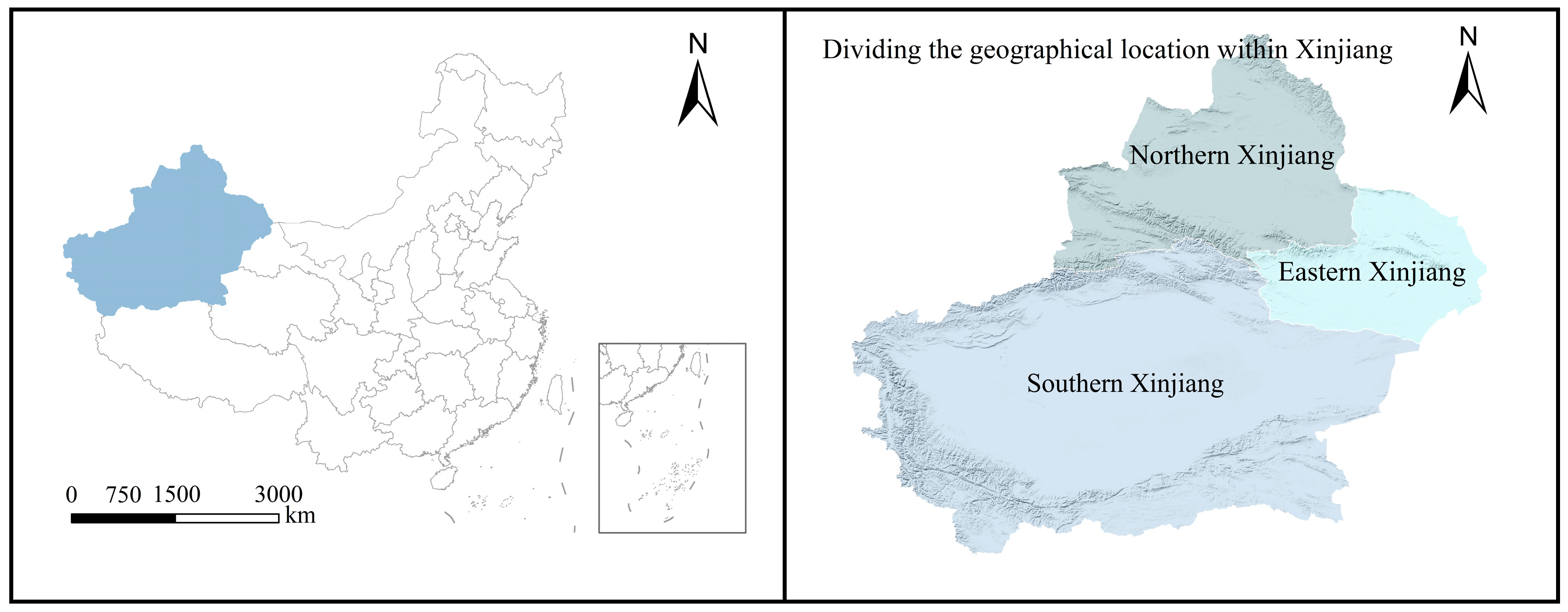
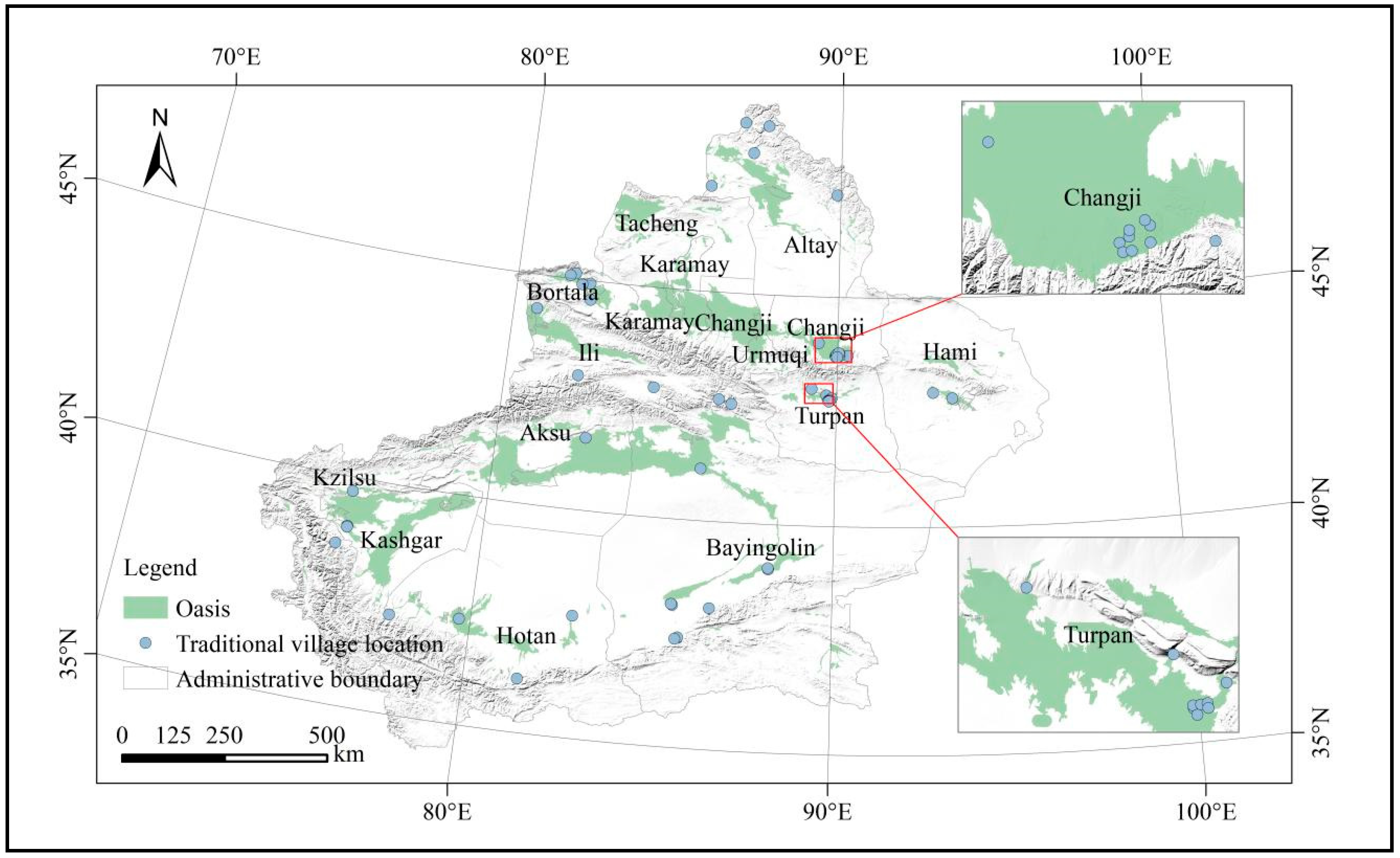
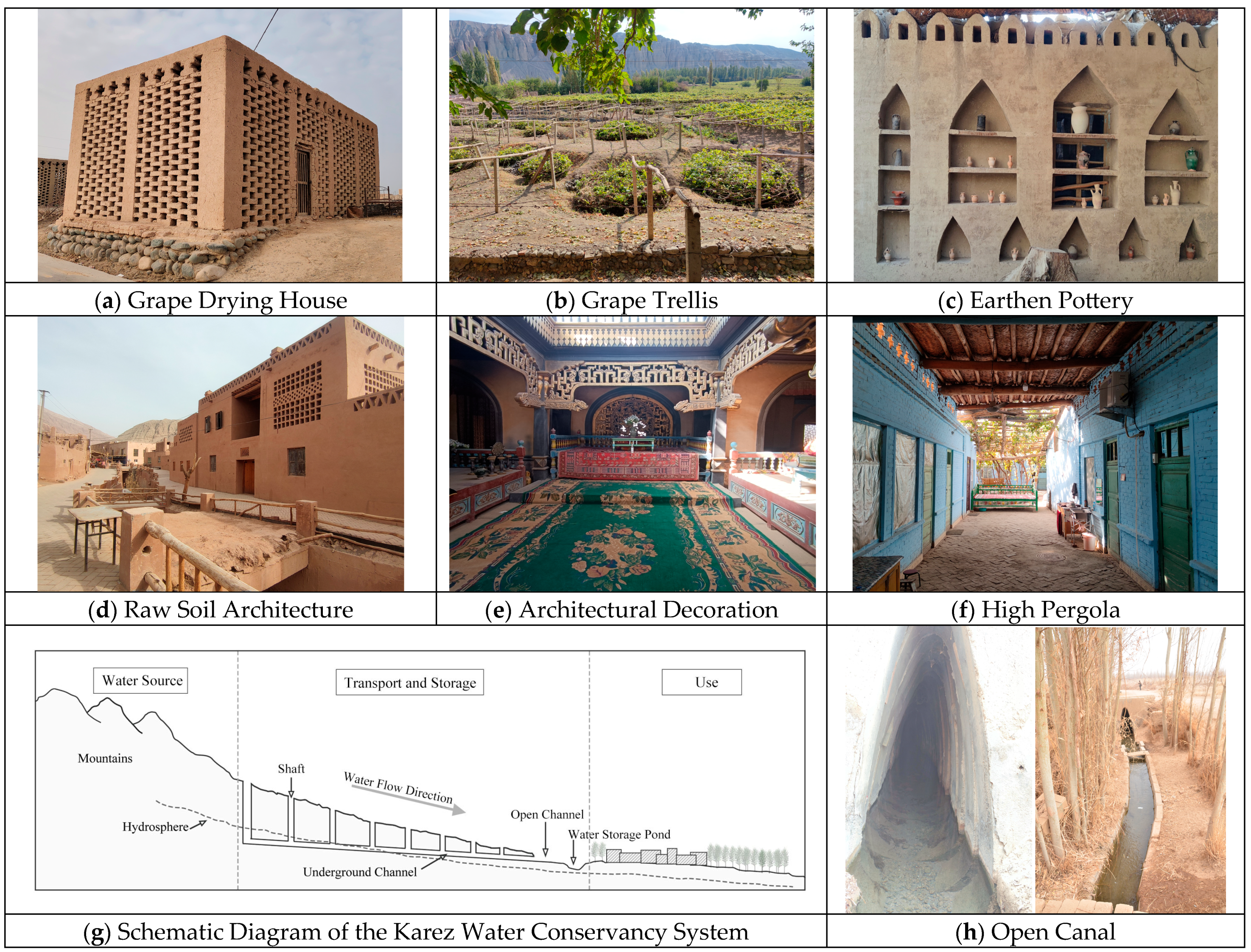
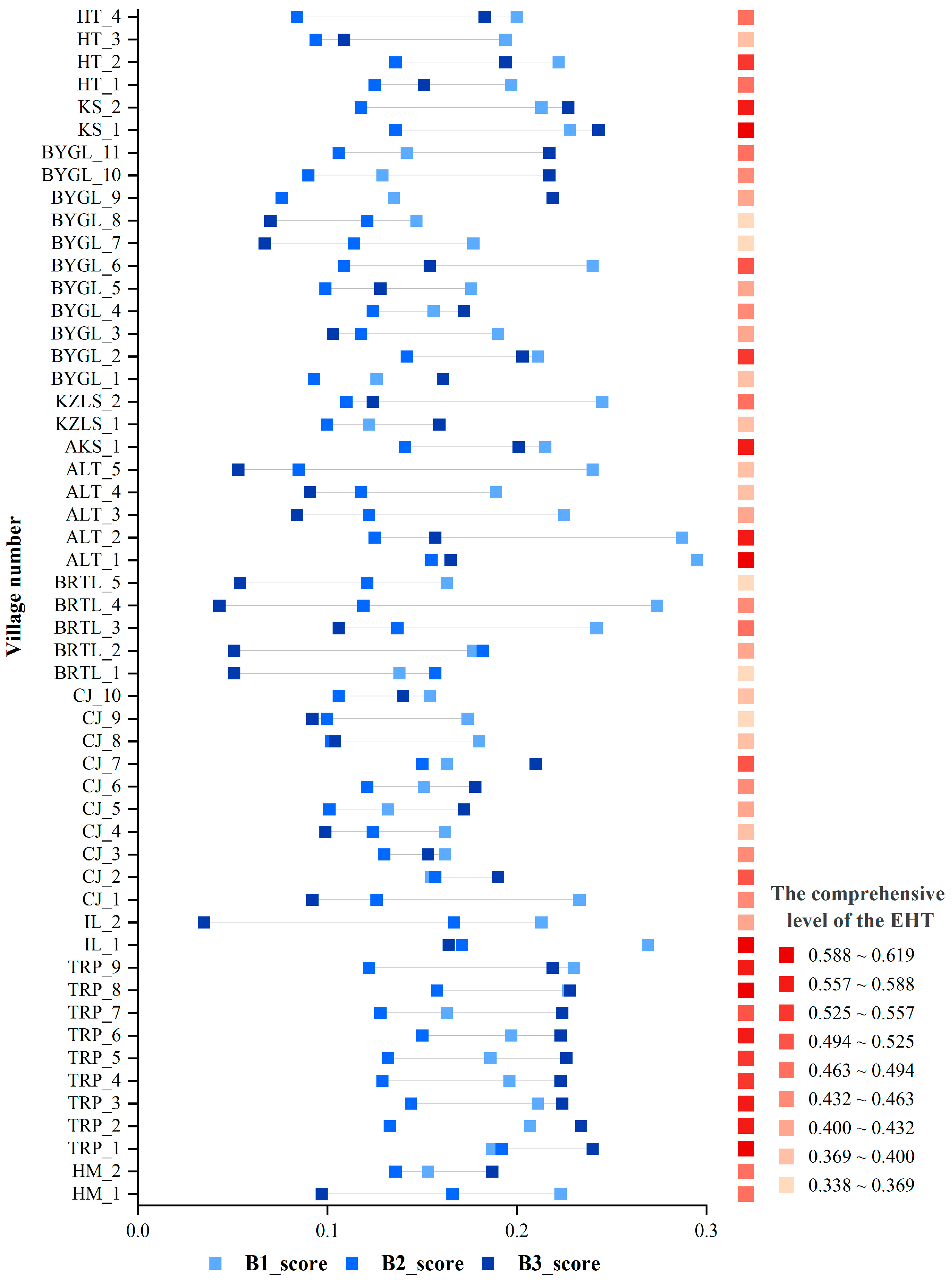
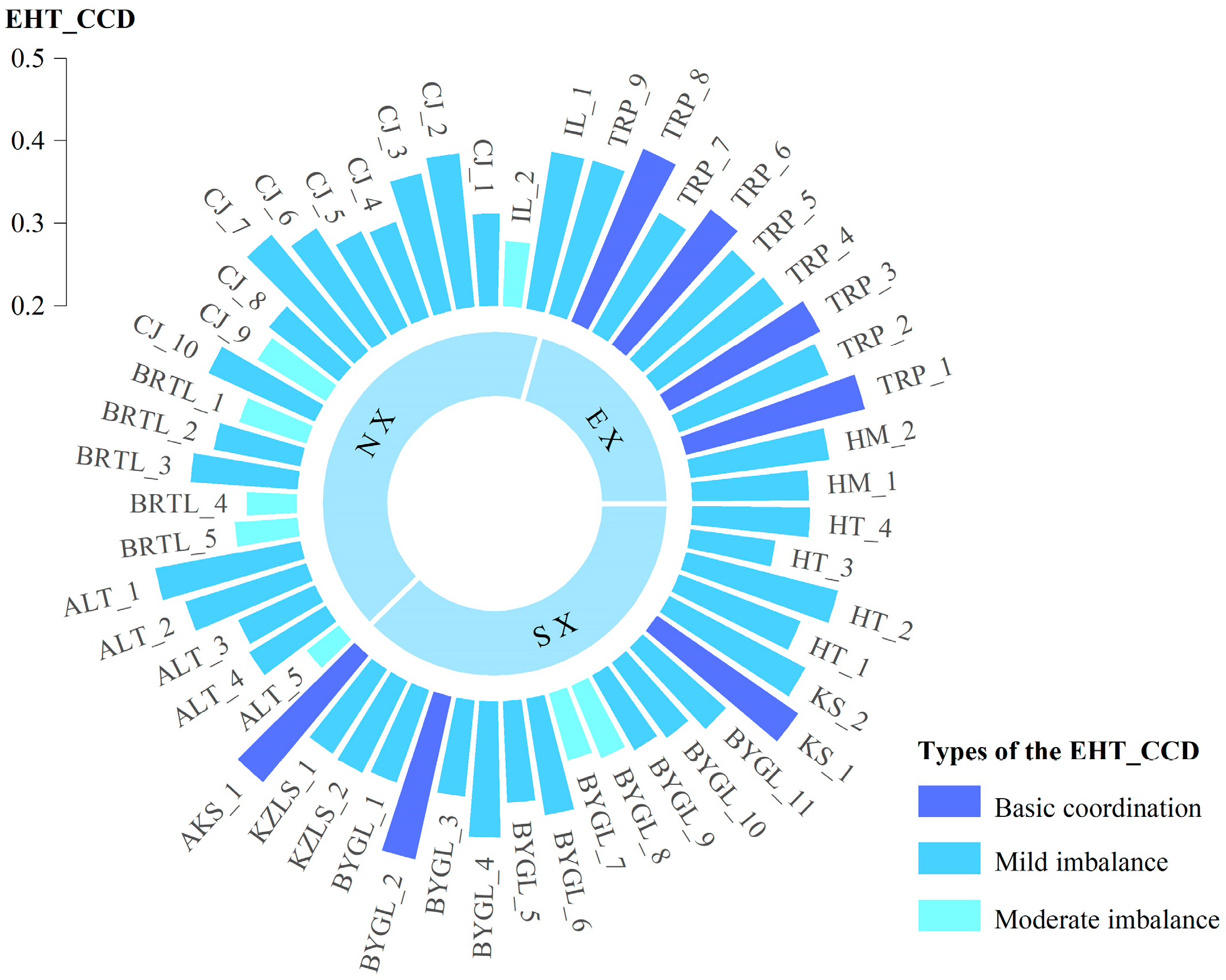
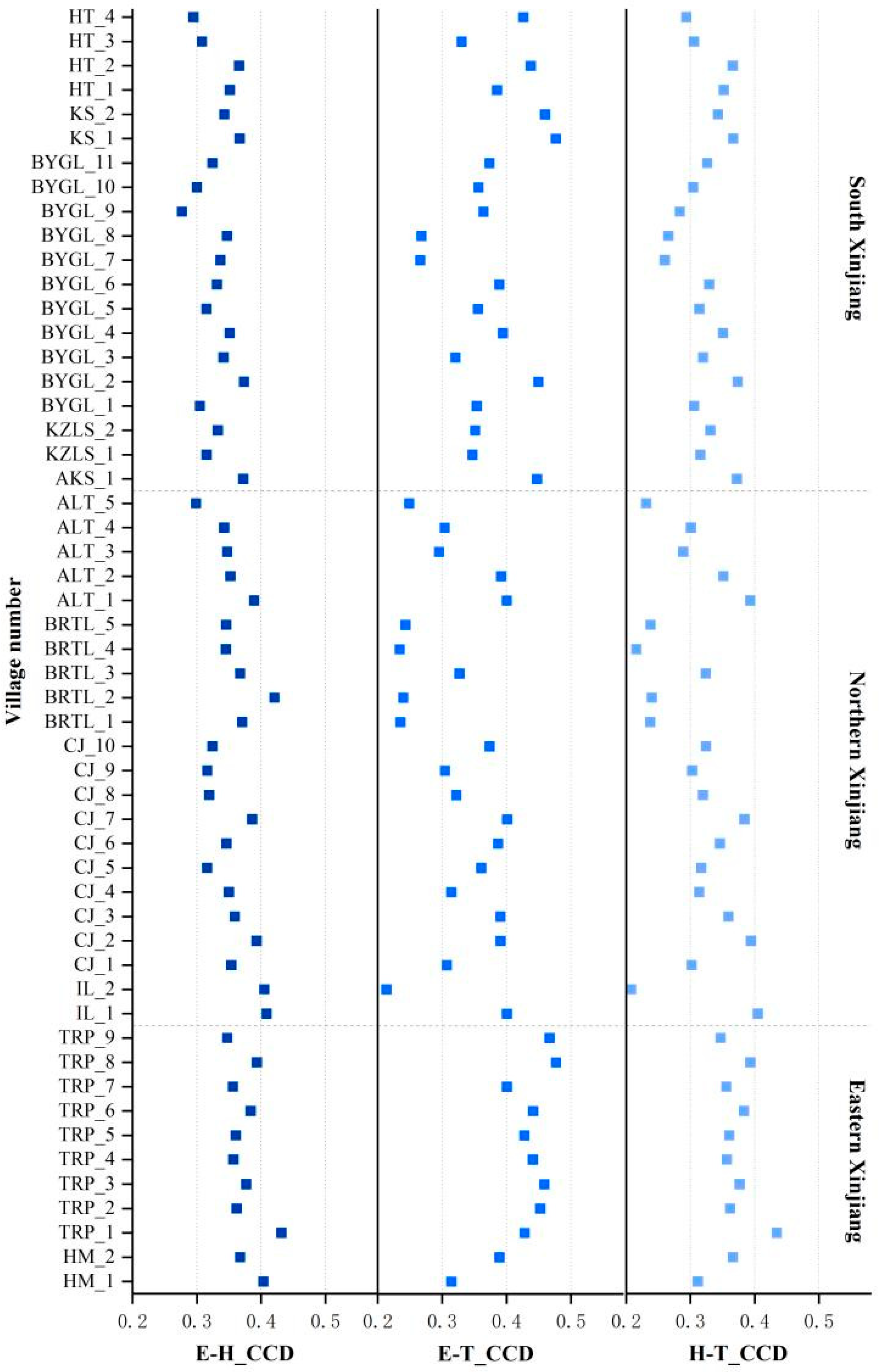
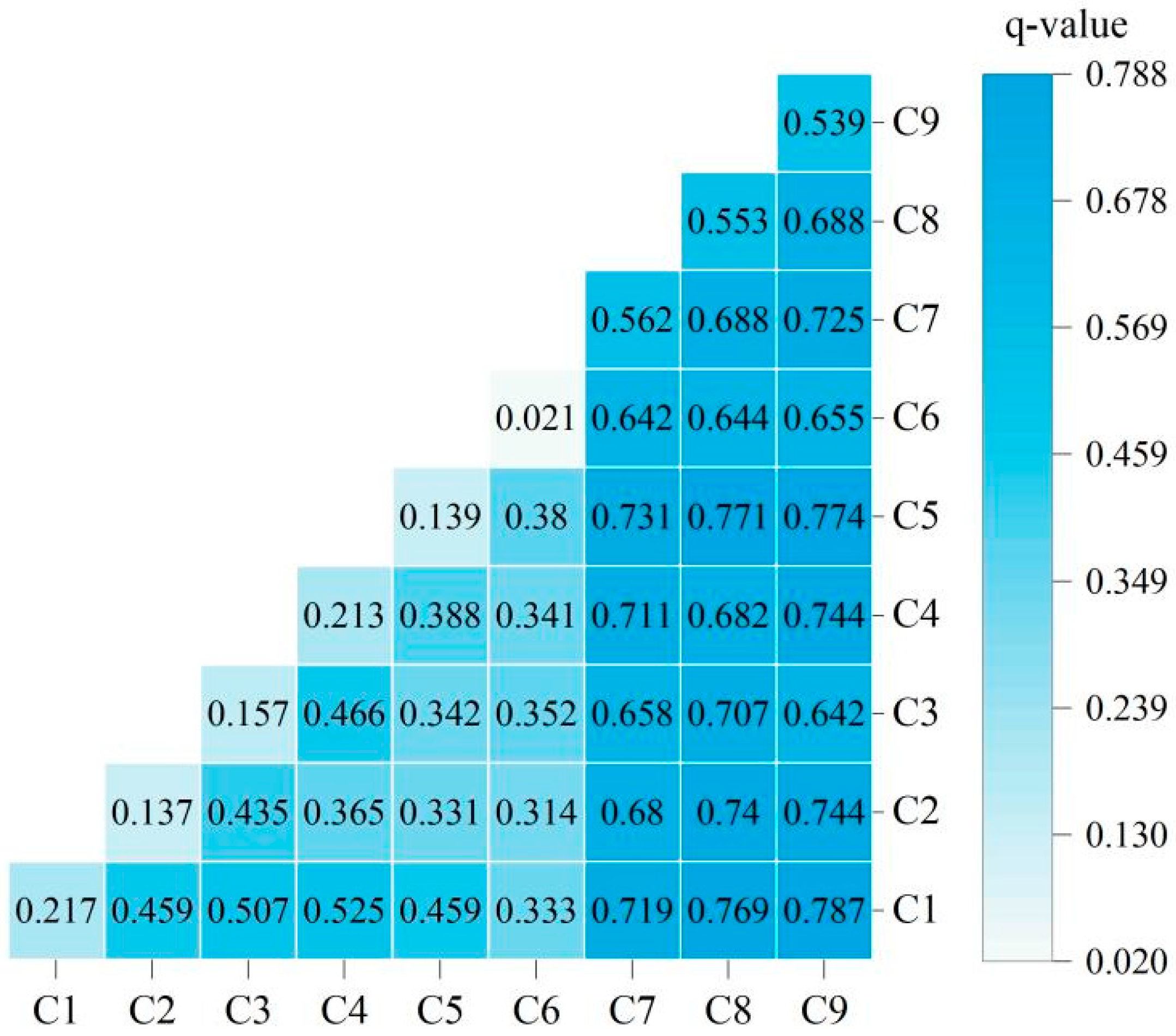
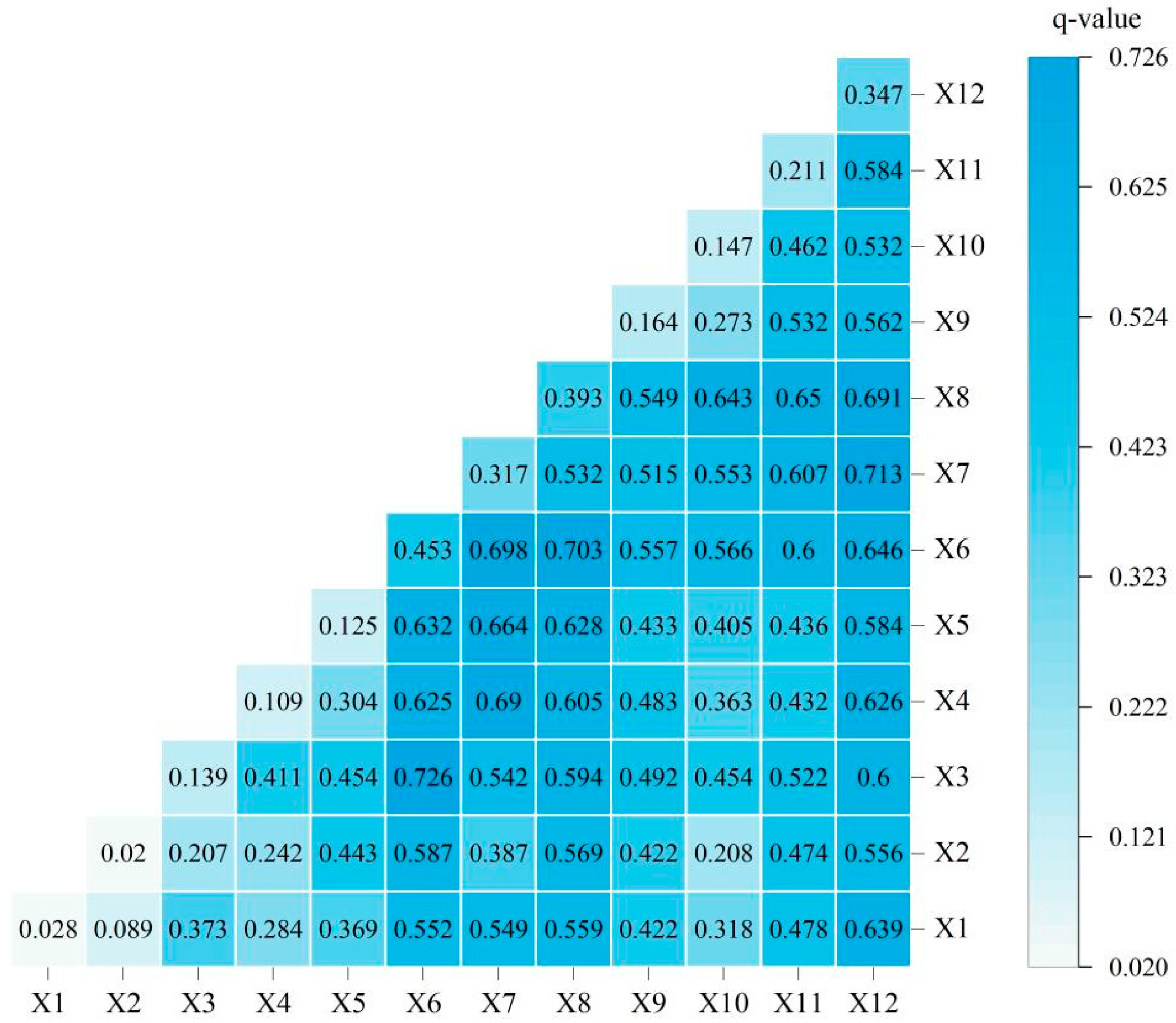
| A Layer | B Layer | C Layer | D Layer | Indicator Type | |
|---|---|---|---|---|---|
| EHT Coupling | Ecology (B1) | Terrain Selection (C1) | Village Topography | Average Slope of Village (D1) | - |
| Average Relief of Village (D2) | - | ||||
| Average Elevation of Village (D3) | - | ||||
| Topography of Building Sites | Coverage Ratio of Buildings (D4) | + | |||
| Morphology of Building Clusters (D5) | - | ||||
| Cohesion Degree of Buildings (D6) | + | ||||
| Water–Green Space Layout (C2) | Morphology of Water–Green Spaces | Coverage Rate of Water–Green Spaces (D7) | + | ||
| Aggregation Degree of Water–Green Spaces (D8) | + | ||||
| Proportion of Largest Water–Green Patch in Landscape (D9) | + | ||||
| Connectivity between Water–Green Spaces and Buildings | Proximity Level between Water–Green Spaces and Buildings (D10) | + | |||
| Connectivity Level between Water–Green Spaces and Buildings (D11) | + | ||||
| Climatic Environment (C3) | Macro-climatic Environment | Annual Average Precipitation at County Level (D12) | + | ||
| Annual Average Temperature at County Level (D13) | - | ||||
| Annual Average PM2.5 Concentration at County Level (D14) | - | ||||
| Micro-climatic Environment | Temperature Stability of Village (D15) | + | |||
| Wind Environment Stability of Village (D16) | + | ||||
| Frequency of Natural Disasters in Village (D17) | - | ||||
| Humanities (B2) | Coordination of Lifestyles (C4) | Annual Average Income of Villagers (D18) | + | ||
| Diversity of Village Industries (D19) | + | ||||
| Synchronization of Villagers’ Production and Living Schedules (D20) | + | ||||
| Proportion of Population Practicing Traditional Dialect, Attire, and Diet (D21) | + | ||||
| Atmosphere of Ethnic–Cultural Customs (C5) | Frequency of Traditional Festivals and Rituals (D22) | + | |||
| Richness of Traditional Music and Dance (D23) | + | ||||
| Continuity Rate of Traditional Etiquette (D24) | + | ||||
| Dissemination Degree of Village Regulations and Conventions (D25) | + | ||||
| Vitality of Social Structures (C6) | Ethnic Composition Ratio (D26) | + | |||
| Cohesion of Social Organizations (D27) | + | ||||
| Permanent Population Rate of Village (D28) | + | ||||
| Population Mobility within Village (D29) | + | ||||
| Technology (B3) | Inheritance Level of Production Technology (C7) | Continuity Rate of agriculture Production Models (D30) | + | ||
| Continuity Rate of agriculture Techniques (D31) | + | ||||
| Continuity Rate of Manufacturing Production Models (D32) | + | ||||
| Authenticity of Manufacturing Techniques (D33) | + | ||||
| Inheritance Level of Architectural Technology (C8) | Authenticity of Architectural Structural Types (D34) | + | |||
| Authenticity of Building Materials (D35) | + | ||||
| Continuity Rate of Architectural Spatial Patterns (D36) | + | ||||
| Continuity Rate of Architectural Decorative Techniques (D37) | + | ||||
| Inheritance Level of Hydraulic Technology (C9) | Continuity Rate of Water Transport and Storage Facilities (D38) | + | |||
| Continuity Rate of Water Transport and Storage Models (D39) | + | ||||
| Maintenance Quality of Hydraulic Facilities (D40) | + | ||||
| D Layer | Cronbach’s Alpha | D Layer | Cronbach’s Alpha |
|---|---|---|---|
| D1 | 0.702 | D21 | 0.699 |
| D2 | 0.701 | D22 | 0.704 |
| D3 | 0.691 | D23 | 0.697 |
| D4 | 0.699 | D24 | 0.685 |
| D5 | 0.699 | D25 | 0.699 |
| D6 | 0.708 | D26 | 0.704 |
| D7 | 0.697 | D27 | 0.701 |
| D8 | 0.710 | D28 | 0.718 |
| D9 | 0.693 | D29 | 0.715 |
| D10 | 0.697 | D30 | 0.681 |
| D11 | 0.721 | D31 | 0.684 |
| D12 | 0.711 | D32 | 0.671 |
| D13 | 0.737 | D33 | 0.685 |
| D14 | 0.720 | D34 | 0.663 |
| D15 | 0.697 | D35 | 0.664 |
| D16 | 0.697 | D36 | 0.683 |
| D17 | 0.729 | D37 | 0.671 |
| D18 | 0.706 | D38 | 0.661 |
| D19 | 0.694 | D39 | 0.675 |
| D20 | 0.713 | D40 | 0.681 |
| Type of CCD | CCD Value Range | Type of CCD | CCD Value Range |
|---|---|---|---|
| Severe Imbalance | 0.000–0.200 | Basic Coordination | 0.401–0.600 |
| Moderate Imbalance | 0.201–0.300 | Moderate Coordination | 0.600–0.800 |
| Mild Imbalance | 0.301–0.400 | High Coordination | 0.801–1.000 |
| Interaction Type | Judgment Basis |
|---|---|
| Reduction of nonlinearity | q(x1 ∩ x2) < min[q(x1), q(x2)] |
| Single factor nonlinear weakening | min[q(x1), q(x2)] < q(x1 ∩ x2) < max[q(x1), q(x2)] |
| Two-factor enhancement | q(x1 ∩ x2) > max[q(x1), q(x2)] |
| Enhancement of nonlinearity | q(x1 ∩ x2) > q(x1) + q(x2) |
| Mutual independence of factors | q(x1 ∩ x2) = q(x1) + q(x2) |
| Dimension | EHT_CCD | E-H_CCD | E-T_CCD | H-T_CCD |
|---|---|---|---|---|
| EHT_CCD | 1 | 0.506 ** | 0.926 ** | 0.923 ** |
| E-H_CCD | 0.506 ** | 1 | 0.156 | 0.392 ** |
| E-T_CCD | 0.926 ** | 0.156 | 1 | 0.867 ** |
| H-T_CCD | 0.923 ** | 0.392 ** | 0.867 ** | 1 |
| Dimension | Code | q-Value |
|---|---|---|
| Ecology | C1 | 0.217 |
| C2 | 0.137 | |
| C3 | 0.157 | |
| Humanities | C4 | 0.213 |
| C5 | 0.139 | |
| C6 | 0.021 | |
| Technology | C7 | 0.562 |
| C8 | 0.553 | |
| C9 | 0.539 |
| Dimension | Indicator | Code | q-Value |
|---|---|---|---|
| Location Conditions | Distance to Township | X1 | 0.028 |
| Distance to County Seat | X2 | 0.020 | |
| Distance to City | X3 | 0.139 | |
| Transportation Conditions | Distance to Nearest National Highway | X4 | 0.109 |
| Distance to Nearest Expressway Interchange | X5 | 0.125 | |
| Village Road Network Density | X6 | 0.453 | |
| Government Policies | Fiscal Funding Allocation | X7 | 0.317 |
| Number of Conservation and Development Projects | X8 | 0.393 | |
| Enterprise Quantity | Number of Limited Liability Companies | X9 | 0.164 |
| Number of Cooperatives | X10 | 0.147 | |
| Number of Individually-owned Businesses | X11 | 0.211 | |
| Online Exposure | Baidu Index | X12 | 0.347 |
Disclaimer/Publisher’s Note: The statements, opinions and data contained in all publications are solely those of the individual author(s) and contributor(s) and not of MDPI and/or the editor(s). MDPI and/or the editor(s) disclaim responsibility for any injury to people or property resulting from any ideas, methods, instructions or products referred to in the content. |
© 2025 by the authors. Licensee MDPI, Basel, Switzerland. This article is an open access article distributed under the terms and conditions of the Creative Commons Attribution (CC BY) license (https://creativecommons.org/licenses/by/4.0/).
Share and Cite
Li, Z.; Ye, J.; Li, Y.; Li, Y.; Zhu, M. Study on the Coupling Coordination Relationships and Driving Factors of “Ecology–Humanities–Technology” in Traditional Villages of the Xinjiang Oasis. Land 2025, 14, 1249. https://doi.org/10.3390/land14061249
Li Z, Ye J, Li Y, Li Y, Zhu M. Study on the Coupling Coordination Relationships and Driving Factors of “Ecology–Humanities–Technology” in Traditional Villages of the Xinjiang Oasis. Land. 2025; 14(6):1249. https://doi.org/10.3390/land14061249
Chicago/Turabian StyleLi, Zhaoqi, Jianming Ye, Yukang Li, Yingbin Li, and Mengmeng Zhu. 2025. "Study on the Coupling Coordination Relationships and Driving Factors of “Ecology–Humanities–Technology” in Traditional Villages of the Xinjiang Oasis" Land 14, no. 6: 1249. https://doi.org/10.3390/land14061249
APA StyleLi, Z., Ye, J., Li, Y., Li, Y., & Zhu, M. (2025). Study on the Coupling Coordination Relationships and Driving Factors of “Ecology–Humanities–Technology” in Traditional Villages of the Xinjiang Oasis. Land, 14(6), 1249. https://doi.org/10.3390/land14061249





